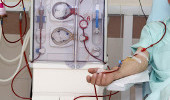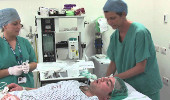In-patient and Day-patient Hospital Treatment
Get a quote nowIn-patient and day-patient care covers most treatments in hospitals and clinics. But what are the differences between them?

Medical treatments are broadly categorized into inpatient and outpatient procedures. It’s important to understand the difference because they impact the length of a patient’s stay in a medical facility, and the cost of a procedure.
In-patient and Day Patient Hospital Treatment: What is the Difference?
The primary difference between in-patient and day-patient care is how long a patient needs to remain in the facility where they undergo a procedure.
In-Patient
In-patient care requires overnight hospitalization. Patients must stay at the medical facility for one night at a minimum. They remain under the supervision of a nurse or doctor during this time.
Day Patient
Patients receiving day patient hospital treatment do not need to stay at the hospital overnight and can leave when the procedure is over. They may need to wait for the anaesthesia to wear off and be monitored for possible complications. However, day patient procedures are usually non-surgical or minor surgical procedures with minimal risk of complication.
In-patient Treatment
In-patient treatment is typically more costly than day-patient treatment. Treatments usually include surgery or costly medical tests and monitoring. Part of the cost is also for use of the hospital bed, and for basic care including meals.
Although exact coverage depends on your health insurance provider and your specific healthcare plan, some in-patient insurance coverage can include:
- Intensive care treatments
- Surgical, anesthetic, operating room fees
- Medicines given during hospitalization
- Diagnostic testing (CAT scans and PET scans, X-Rays and laboratory tests)
- Medical vehicle transport expenses
- Surgical appliances and prosthetic device expenses
- Organ transplants
- Private quarters during surgery or recovery.
Day Patient Treatment
Unlike with in-patients, day-patient treatment requires relatively few resources and is therefore usually less expensive.
Depending on your medical policy day patient insurance can include coverage for:
- Prescription medication for some or all prescribed medicines
- Vaccinations
- Diagnostic tests (X-Rays, CAT scans, blood tests, etc)
- Doctor’s fees
- Other medical practitioner costs (nurses, wardens, specialists, etc)
Some medical plans may also include coverage for alternative therapies such as Traditional Chinese Medicine (TCM).
Summary
If you are wishing to make a claim on your medical insurance plan you should inform your healthcare insurer of the type of treatment you require, including whether you will be regarded as a day patient or an in-patient.
It is good to be informed of what your insurer offers in terms of covered inpatient and day-patient treatments. CompareInsurance makes it easy to compare insurance policies to make sure you get the coverage you want and need.
In this article
In-patient and Day Patient Hospital Treatment: What is the Difference?
In-Patient
Day Patient
In-patient Treatment
Day Patient Treatment
Summary
Our top health insurance guides / articles
View all health insurance guides

Joint Health Insurance
Why a joint health insurance policy cound be perfect for you and your partner?

Treatment for kidney dialysis
More than 2000 patients living in the UAE are currently undergoing dialysis

Medical aid for pensioners
Senior citizens are one demographic which may be compromised when it comes to premiums on medical aid

Specialist Consultations
Pediatricians, dermatologists, obstetrician/gynecologists, anesthetists, and ophthalmologist specialists

Healthcare Cash Plans
Some policies would pay out cash weekly as a benefit if the policyholder is admitted to the hospital

Self-pay Healthcare Plans
This would be a great option if you do not want the monthly or annual premiums

Types of healthcare insurance
Each medical insurance policy would be different and every insurance company would offer different types of medical insurance plans

Features and benefits of healthcare insurance
There are many different types of medical insurance and the features and benefits of each policy

How to get affordable health insurance?
It’s very simple and you have to take the time and compare a range of medical insurance plans

How to choose the best health insurance for you and your family?
If you are a first-time medical insurance policy buyer or currently shopping around we have put together some tips

Private health insurance
Your employer would give you basic health insurance but that is not always enough for your need

What To Do When a Loved One Passes Away
This is not an easy time for anyone but it’s important to prepare for these unfortunate events.

Why you and your family needs health insurance
Paying medical costs out of your packet can be financially crippling and you can’t put a price on health

What does health insurance actually cover you for?
The basic sector would most likely exclude dental, ear and eye care which is crucial for all people

Medical Coverage Plans
A health insurance plan is one of the best and safest ways to ensure you have financial cover in the case of a medical emergency

How co-pay works on your health insurance policy?
Some insurers call the co-payment “excess” and this can be a specific amount or a percentage of the claim.

Medical repatriation
Check your policy to understand if medical repatriation is a benefit, this means would your medical insurance cover you

Medical Aid for Students
Student medical aid would be at a more affordable rate for students who are still busy studying

Plans for pre-existing conditions
You can get personal financial solutions that fit your life and budget as your life changes

Is medical aid affordable?
It’s possible that you can tailor your health plans or choose your medical aid to best suit your needs and your pocket

Rehabilitation Treatment
This benefit offers you a holistic approach to treating your pain by highly trained professionals

What’s Covered in Regional Healthcare Policies?
Regional healthcare policies cover residents in the UAE and other GCC countries. The coverage and pricing of these policies can vary greatly

What’s Covered in International Healthcare Policies?
International health insurance should offer comprehensive cover for people living abroad

What Hospitals Are Included in Your Network Tier on Your Health Insurance Policy?
Health insurance tier systems should help consumers compare similarly priced health plans

Treatment in Intensive Care
IC treatment deals with the most critical cases and involves special procedures and monitoring

Outpatient Consultations, Diagnostic Tests and Prescribed Drugs
Many medical plans include “outpatient cover”

In-patient and Day-patient Hospital Treatment
In-patient and day-patient care covers most treatments in hospitals and clinics. But what are the differences between them?

Anaesthetists Roles and Fees in Health Insurance
Like surgeons, anaesthetists may charge a separate fee for their services during medical procedures

Surgeons Roles and Fees in Health Insurance
How does your health insurance handle surgical fees, and what is the surgeon’s role in your health plan coverage?

Help with Costs to Return After Treatment
One of the options available under many healthcare plans is cover for the cost of returning to the UAE after treatment abroad

Radiology Tests
Radiology, also known as diagnostic imaging, is the science of diagnosing and treating various types of diseases

Transplant Services
In the UAE, health plans cover the cost of organ transplants. Costs for the acquisition of the organs is, however, not necessarily covered.

Treatment Administered by a Registered Acupuncturist
In the UAE, coverage for alternative treatments such as acupuncture are usually associated with high-end plans only

Compassionate Visits
This additional insurance covers the cost of travel for a family member to visit you should you be hospitalized

Personal Health Insurance
Having personal health insurance is an advisable preventative measure against unexpected health costs

Can I get Health Insurance If I Smoke?
Here’s what you need to know about smoking and health insurance









 Physiotherapy
Physiotherapy






